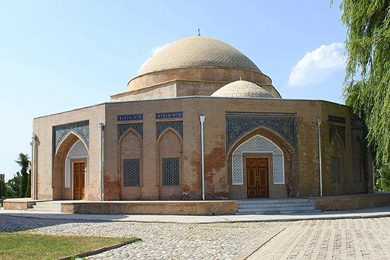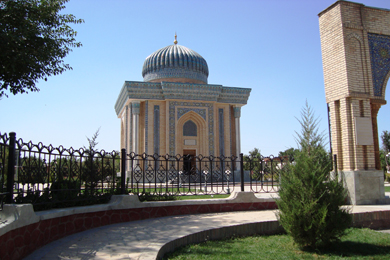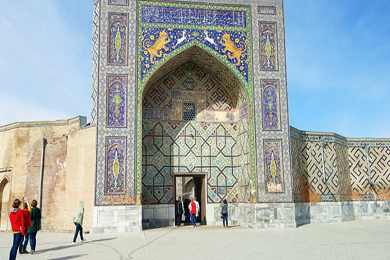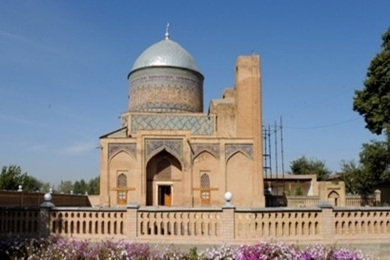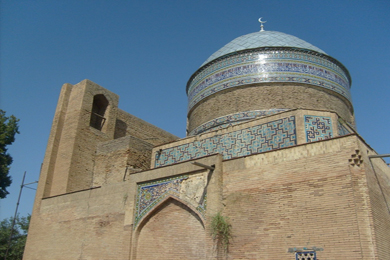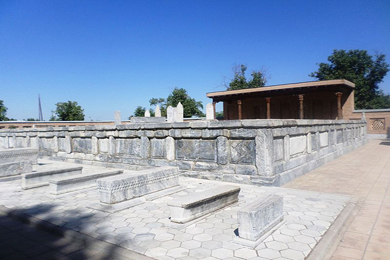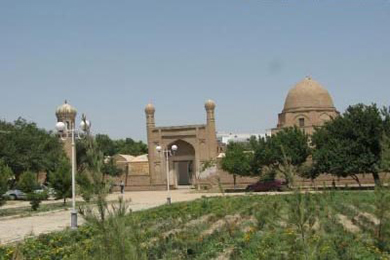Sights Of Samarkand
History of Samarkand - this legendary and unique city - contains over 2000. Modern Samarkand - the second city of Uzbekistan after Tashkent on population and the territory, industrial value. Zaravshan is located in a left-bank hilly part of an average watercourse. The nature endowed Samarkand with fine climate and clear water - it was stretched in one of heavenly spots of the earth Uzbek. The main waterway of the city are the Zarafshan River, canals Dargom, Siab, Shau-a gift.
Hazrati Dovud, also known as Hazrat Dovud or Hazrat Daud (it is translated into Russian as Saint David) — the cave, the holy site attracting annually large number of visitors and pilgrims. It is near the kishlaks Aksay and Mekhnatkash located in Nurabadsk district of the Samarkand region of Uzbekistan, in 30 kilometers to the southeast from the city of Nurabad and in 70 kilometers to the southwest from the city of Samarkand.
- Details
- Category: Sights Of Samarkand
- Hits: 2
Trade dome of Chorsu — the historical memorial building located in the central part of the city of Samarkand (Uzbekistan) to the northeast from the area and ensemble Registan, on Tashkent Street. Now carries function of the museum and gallery. Together with other architectural and archaeological historical monuments of Samarkand, enters the list of the World heritage of UNESCO. The name Chorsu is literally translated from Persian as four ways / are expensive.
- Details
- Category: Sights Of Samarkand
- Hits: 3
The mosque of Kosh House was built in Samarkand in 1319 on Hijra (1899) what the special inscription testifies to. The mosque of Kosh House was built in Samarkand in 1319 on Hijra (1899) what the special inscription testifies to. According to one of the attendant of the mosque Amrillo Zubaydullayev, this cult construction was erected on remains of earlier mosque. It is quite probable that this place was chosen because there were two ancient house providing people with drinking water. From here and the name of the mosque of Kosh House - ("Two (steam) of a house").
- Details
- Category: Sights Of Samarkand
- Hits: 2
Hodge-Nisbatdor's mosque — the mosque of the end of the 19th century in Samarkand, is located in the downtown to the south from the square Registan. It is called in honor of the theologian Hodzhi Nisbatdor living till the 15th century. The mosque is built of a burned brick, enclosed ayvany and has a minaret. In Soviet period, the building of the mosque was used as post office. In 1998 it resumed the work.
- Details
- Category: Sights Of Samarkand
- Hits: 2
Mausoleum of Khoja Daniyar— the mausoleum in Samarkand located on North side of Hill Afrasiab. It was constructed on the place of burial and the mosque of times of Tamerlan in 1900.
- Details
- Category: Sights Of Samarkand
- Hits: 2
Abu Mansour Maturidi's (Moturidiy yodgorlik majmui) mausoleum — the mausoleum in Samarkand located in kilometer to the southeast from the area and ensemble Registan. The mausoleum is erected over Abu Mansour Mahomed ibn Mahomed's grave of Al-Maturidi (870 — 944), the famous Islamic theologian, expert on fiqh (Muslim law) and the interpreter of the Koran (mufassir), the founder of a maturidizm. He was buried at the Samarkand cemetery Chokardiza where, according to the legend, more than 3000 scientists-theologians are buried. Over a grave the mausoleum destroyed in the 1930th years was built. The mausoleum is in the central part of the city of Samarkand, in the territory of the so-called old city, between streets Vabkentsk, Bukhara and Gizhduvan, in about a kilometer to the southeast from the area and ensemble Registan.
- Details
- Category: Sights Of Samarkand
- Hits: 2
Hodge-Akhrar's ensemble — the complex of constructions of memorial, cult and spiritual and educational appointment which developed in the XV—XX centuries on the suburb of the ancient cemetery Dzhakerdiza in the southern residential suburb of the city of Samarkand (Republic of Uzbekistan). The radical reorganization of ensemble, which completely changed its original form, was carried out in the first half of the 17th century. Additions were made in the 19th and 20th centuries. Emergence of ensemble is connected with a name large religious and the statesman of Transoxiana sheikh Nasyr Ubaydallakh ibn Mahmoud Shasha's hell dyne better known under the name of Hodzhi Akhrara of Valya. Its grave, which is in the territory of a complex, is one of the most esteemed Islam shrines in Central Asia.
- Details
- Category: Sights Of Samarkand
- Hits: 2
Abdi-Darun (Abdou-Darun's) ensemble — the complex of constructions of memorial, cult and spiritual and educational appointment at the Old cemetery of Samarkand (Republic of Uzbekistan) which developed in the XII—XX centuries at a grave of the famous Islamic jurist of the 9th century Abd-is scarlet Mazeddina. An ancient kernel of ensemble is the mausoleum of the 12th century near which were at different times constructed a hanaka, the mosque and madrasah. The radical reorganizations of ensemble significantly changing its appearance were carried out in XV, 19th and 20th centuries. Abdi-Darun's ensemble is one of the most esteemed Islam shrines in Central Asia.
- Details
- Category: Sights Of Samarkand
- Hits: 3
Ensemble Abdi Birun — a complex of constructions of the first half of the 17th century of memorial and cult appointment in the southern suburb of Samarkand (Republic of Uzbekistan). The sofa is constructed in the 1630th years by the vizier and the uncle of the governor of the Bukhara khanate Imamkuli-hana Nadir - run on a mazara of the 12th century. It is considered one of the largest medieval memorials (hazir) in the territory of Central Asia.
- Details
- Category: Sights Of Samarkand
- Hits: 3
Yalangtush Bahadur also Zhalantos Bahadur (in the world oriental tradition Yalangtush Bahadur), (1576, Nurata, Bukhara Khanate - 1656, Samarkand, Bukhara Khanate) - military leader, Biy, politician, ruler of a large inheritance, governor (emir) of the Bukhara khans. His name seems to be a lifetime nickname, a variation of the name "Yalangtush Bahadur" literally translates as "a hero with an open chest." Origin: According to one version, Zhalantos was born in the Syr Darya lands in 1576, in the clan nomads of the Kazakh clan Tortkara (Alimuly tribe).
- Details
- Category: Sights Of Samarkand
- Hits: 3
Makhdumi Agzam — Makhdum-i Ajzam (a full name Said Jalal hell dynes Ahmad al-Kasani ad-Dakhbedi — Shaykh Aḥmad ibn Mawlgng Jalgl al-DMN Khwgjagm KGSGNM 'Makhdtsm-i A am', (1461 — 1542) — the Islamic theologian and the mystic from Central Asia, the representative of Sufism, the founder of Dakhbediya school, the large theorist and the sheikh of the doctrine of Naqshbandi.
- Details
- Category: Sights Of Samarkand
- Hits: 2






